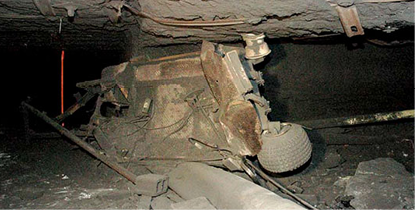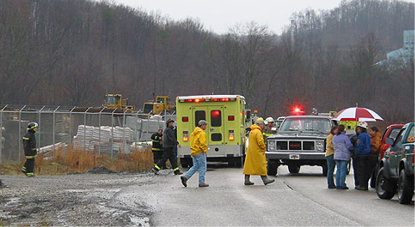The changing weather and increased activity at many of the nation’s coal mines that can so often be tied to a rise in fatal accidents has, at least so far, not been a continued trend in the spring and summer of 2016. Between April and June, there were a total of two coal mining deaths, both of them underground and both of them in the bituminous coalfields. The victims also had multiple years of mining experience.
On May 16, following a quiet April, a powered haulage incident took the life of 50-year-old Eric Meddings, a motorman at Arch Coal’s ACI Tygart Valley Leer mine in Taylor County, West Virginia. The 14-year mining veteran was working as a lead motorman transporting empty supply cars to the slope bottom along with the tail motorman.
According to the Mine Safety and Health Administration (MSHA), while switching the cars through a set of airlock doors, the tail motorman heard the lead motor go through a closed airlock door.
“When he got to the lead motor, he found the victim unresponsive and slumped over in the operator’s seat,” preliminary findings of the incident revealed. “The tail motorman immediately phoned for help and started CPR within 5 minutes of finding the victim.” Meddings was pronounced dead at an area hospital.
The death was not initially listed as a mining-related death; officials with the state Officer of Miner’s Health, Safety and Training were among those investigating the event who initially felt the victim suffered a medically related issue. In late June, it was revealed that Meddings died of injuries sustained in the incident.
“The damage of going through the [airlock] doors resulted in the blunt force trauma that killed the front motorman,” MSHA said.
At press time, a fatalgram report with more information and best practices for prevention had not been released, nor had the agency’s final investigative findings been published.
The afternoon of June 6 in Illinois, 34-year-old contract laborer Robbie Clark was killed in a machinery accident at the American Coal Co. New Era operation in Galatia, Saline County. At press time, it was also the most recent coal mining-related fatality.
Clark, who had seven years of mining experience, had a little more than five weeks in as a laborer, but accident details showed he had only worked at the Murray Energy-owned (as a contractor for David Stanley Consultants).
MSHA’s preliminary report said the victim, who was moving gravel, was killed after the diesel front-end loader he had been operating fell on him.
“For some reason, he lowered the bucket and put downward hydraulic pressure on the bucket to raise the middle of the loader up,” agency investigators said.
“The victim and another miner, a company mine manager, crawled under the loader to check something, possibly a hydraulic [fluid] fuel leak. The hydraulic pressure released, allowing the loader to lower onto and trap the two men under it.”
According to the report, it was a pre-shift examiner who heard a call for help while passing by; that individual found the pair beneath the loader and placed pressure on the bucket again to raise the machine off of them. Clark was unresponsive after being freed, and CPR efforts were not successful.
A fatalgram report released shortly after the incident largely repeated the preliminary information as to cause, and stressed that miners not work under suspended load as part of a group of best practices for prevention of similar events in the future.
“Never depend on hydraulics to support a load,” MSHA officials said. “Use the manufacturer’s recommendations to lift and block equipment against hazardous motion before [capitalized for emphasis] starting any repairs.”
The agency also urged workers to never proceed with repairs until all safety concerns have been adequately resolved, and to conduct examinations from safe location and verify release of or full control of all stored energy before beginning repair work.
MSHA also has asked miners, in addition to ensuring proper safety training and establishing and discussing safe work procedures, to always treat suspended loads as unblocked until blocks or jack stands have been placed and full support has been verified.
At press time, a final federal investigation report was still pending on this incident.
A 34-year-old contract laborer died underground at Murray American’s New Era mine in Illinois in early June.
More Information Released on Huff Creek
On April 8, MSHA issued its fatalgram report for the March 23 fatal underground accident at Arch Coal’s Lone Mountain Processing Huff Creek No. 1 operation in Kentucky that took the life of 30-year miner Mark Frazier, 48.
In the alert, investigators said the victim received fatal injuries when an overhanging section of a rock rib fell, pinning him against the mine’s haulage equipment. The fallen rib was measured at 44 feet long, 4 ft wide and 2 ft thick. Frazier, as MSHA also reported in its preliminary findings, had been remotely operating a continuous miner (CM) to excavate material during the construction of a coal transfer shaft when the fall occurred.
The area where the accident occurred had a depth of cover of approximately 1,950 ft and a height of approximately 17 ft. Frazier had worked at the Harlan County mine for more than 14 years and had seven years of experience as a CM operator.
MSHA has not released its final report on the death, the fourth recorded in 2016.

The scene of an accident at Dana Mining’s No. 4 West operation in Pennsylvania that resulted in the death of one miner in January.
Final Report Released for Dana 4 West
On June 3, MSHA released its one and only coal mining fatality-related final report to detail the conditions leading up to the death of Jeremy Neice, 31, at Dana Mining’s No. 4 West mine in Greene County, Pennsylvania, on January 16.
The fatality at the mine owned by GenPower Holdings was the second of the year and was classified by the agency as a Fall of Face, Rib, Pillar or Highwall.
“[The] continuous mining machine operator with 13 years of experience was fatally injured when he was struck by a large section of the mine rib,” the report began. “[He] was operating a remote-controlled continuous mining machine in the I Sub-Main section when a large portion of the right side rib fell pinning him to the mine floor, causing fatal crushing injuries.”
The report indicated that, during the early evening shift, Neice had mined about 18 ft out of “Run A” when another worker who witnessed the incident positioned his ram car behind the continuous mining machine to receive a load of coal.
“As Neice loaded the ram car, Keller heard a loud ‘bang,’” MSHA investigators said of the witness report. “He observed the rib rolling away from the coal block, striking Neice from behind, and pinning him to the mine floor. Keller stated that Neice was standing along the right side rib, approximately 5 ft inby crosscut 21 when the accident occurred.”
It took several workers to free the victim from the fall; a faint pulse was detected at that time and he was transported about 9,000 ft to the mine’s Marshall Portal. CPR efforts were made, but he was pronounced deceased at a local medical center.
MSHA ultimately concluded that the mine’s operator failed to identify and effectively control adverse rib conditions present on a working section.
“[The] operator received fatal crushing injuries when the mine rib rolled away from the coal block and pinned him to the mine floor,” officials said. “Deteriorating conditions existed prior to the accident indicating rib support was needed to protect miners from hazards relating to falls of mine ribs.”
In its corrective actions, the agency ordered the operator to revise its approved roof control plan to identify remnant pillar areas in the underlying mine that could contribute to poor rib conditions. That revised plan also requires rib support to be installed in-cycle in these areas inby the last open crosscut.
Additionally, the mine corrected hazardous mining conditions and examiners were retrained to properly evaluate and identify them as well as how to remedy any future issues.
Two 104(d)(2) significant and substantial (S&S) orders were issued to the No. 4 West operation as a result of the incident; the first cited a violation of 30 CFR Section 75.360(b)(11)(i) for a failure to identify adverse rib conditions.
“These conditions were obvious and extensive. This is an unwarrantable failure to comply with a mandatory standard,” MSHA said.
The second 104(d)(2) S&S order cited 30 CFR Section 75.202(a) for the mine’s failure to control the section’s ribs. The agency also revealed that standard 75.202(a) had been cited 15 previous times over two years at the mine.

One worker was killed in an underground powered haulage incident at the Leer mine on May 16.
Sago, Aracoma and Darby: 10 Years Later

A mine explosion at the Darby operation in Kentucky in 2006 killed five. In all, 47 coal miners died that year.





